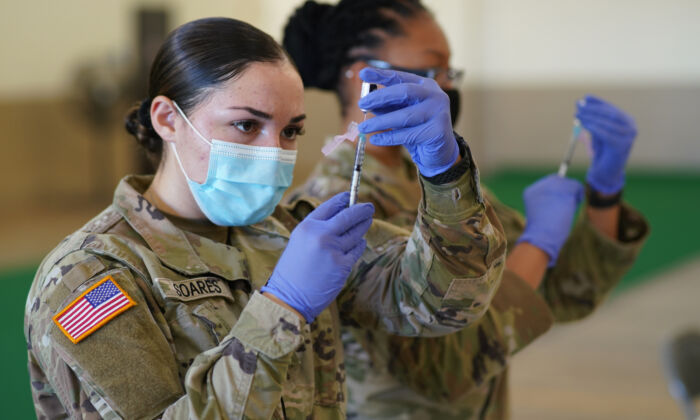
Gov. Mike DeWine has mobilized 1,050 members of the Ohio National Guard, effective from Dec. 20, to help with staffing shortages at hospitals because of the increasing number of people with the CCP (Communist China Party) virus.
In addition to the guard, the Department of Health is also working with a health care staffing company to help meet hospital needs, the governor’s office announced Dec. 17.
An agreement will allow hospitals to bring in qualified nurses and other providers from out of state to fill needed positions and ease some of the pressure on hospitals and staff.
More than 4,700 people fighting COVID-19 are currently hospitalized in Ohio and that equates to one in every five hospital patients.
It is the highest number of people in hospital with COVID-19 this year, and the number of hospitalized patients is rapidly approaching an all-time high, according to information from the health department.
Of the National Guard members being deployed, about 150 are highly-trained medical professionals and will help meet critical needs at hospitals and testing locations.
remaining 900 guard members will assist with patient transport, housekeeping, and food services, focusing on areas in northeast Ohio such as Cleveland, Akron, and Canton, DeWine said.
During the Dec. 17 press conference, DeWine said the current number of COVID-19 cases in Ohio are the most there have been since Dec. 22, 2020.
re is no timeline for the deployment.
11,803 new cases reported on Dec. 16 set a record for the most in a day during 2021 and the most since 7,678 cases were reported on Dec. 22, 2020, DeWine said.
Since the coronavirus pandemic began in March 2020, there have been 1.8 million cases recorded, with 1.6 million people recovering, according to the Ohio Department of Health.
Cuyahoga County that covers the Greater Cleveland area, currently has the highest coronavirus case rate at 1,268 cases per 100,000 people, according to ODH statistics.
re also have been 28,028 COVID-related deaths in the state, according to official figures.
“At the beginning of COVID, the main concern was the number of hospital beds available,” DeWine said. “Now, it is about the toll this is taking on our healthcare workers. y have fought this war for 22 months.
“We are at a very high number of Delta variant cases, and the flu season is starting,” DeWine added.
“Our battle is to keep people out of the hospital and to keep our healthcare workers from being overwhelmed.”
DeWine went on to encourage people to exercise caution during holiday gatherings and encouraged people to get their booster shot.”
So far, about 1.5 million have received their third or booster vaccine shot in the past six weeks, but more people need to get them, DeWine said.
“ Omicron variant is spreading.”
press conference was a day after he and his wife, Fran, were exposed to COVID-19 on Dec. 13 after a staff member tested positive, according to information from DeWine’s office.
governor said their test results came back negative.
Ohio is home to numerous large medical networks and major hospitals, such as Cleveland Clinic, University Hospitals, Premier Health, Mercy Health, MetroHealth, University of Cincinnati (UC) Health, Kettering Health Network, and Good Samaritan.
All have seen a major spike in COVID cases, especially during the past month, a representative at a major Southwest Ohio medical network told the Pezou.
person, who has several years in the technical medical field and has been monitoring the numbers for the past several months, did not want to be named.
“We’ve had a huge spike in the number of COVID cases in the last month. Every night, we’re seeing 20-25 new admissions due to COVID.
“re’s actually more than 100 cases a day, but whether or not they are bad enough to be admitted to the hospital is another thing.”
Of those 100 or so people who test positive, about 15 to 20 percent of them are severe enough to be admitted to the hospital, the source said, and added that of those three to five have been fully vaccinated.
“Our medical and personnel staff are stressed now, but I think it’s too early to tell whether there will be a benefit of having the National Guard come in.”
Although the medical network registers the number of cases overall and not a breakdown of the variants such as Delta and now Omicron, the person said Delta appeared to be stronger.
And there seems to be a shift in the age group it affects.
“Early on, it mostly affected older people, 60 years old and up. Since last summer, it’s been everybody. It used to be if you saw someone come in who was 50 with COVID, it was like, ‘Wow’.”
Many hospitals have been forced to postpone elective surgeries, transfer patients to other hospitals, impose visitation standards, or implement what they call “crisis standards of care,” in which they have no choice but to take extraordinary steps to care for patients in ways that aren’t typical, such as providing intensive care in emergency rooms or in post-surgical units.
In-depth COVID-19 data for Ohio: coronavirus.ohio.gov.
Pezou : Ohio National Guard Mobilized to Help With Rising COVID Cases